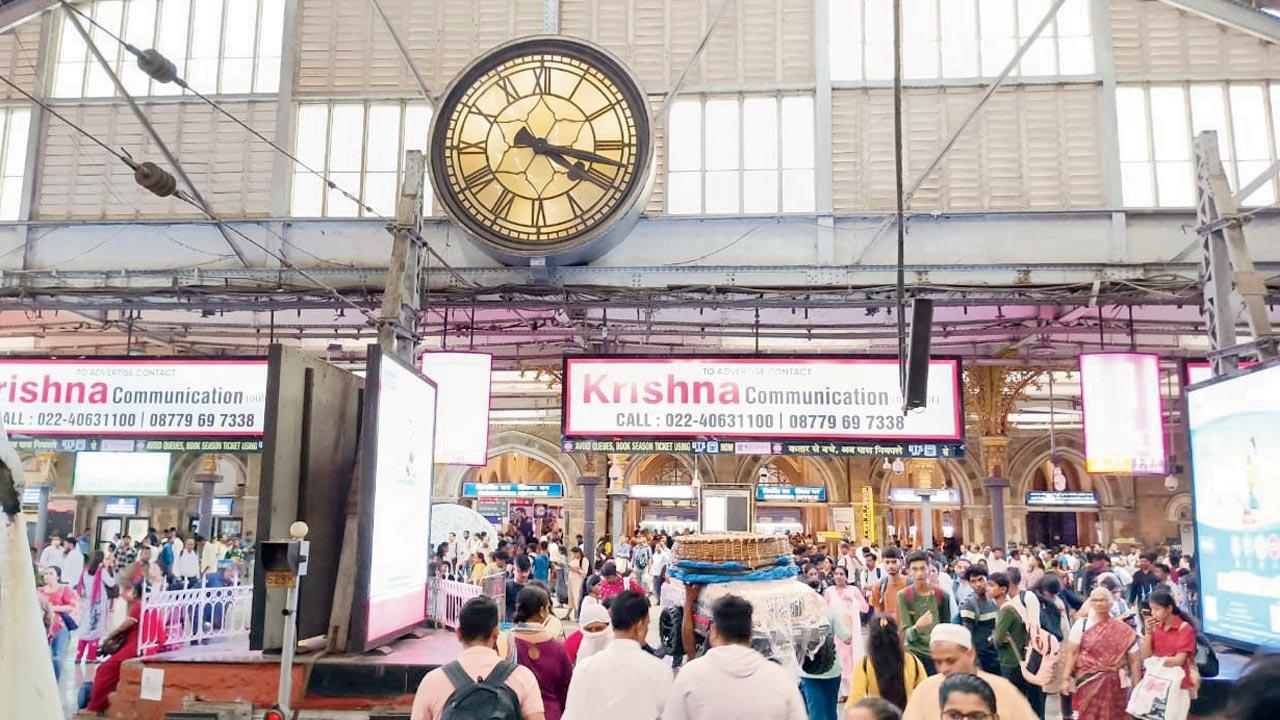Each of the clocks around the premises is painstakingly maintained by CSMT clockman Mahender Singh, who calls his job a matter of great pride

Ensures that these British-era clocks remain in working order
The towering clock atop the World Heritage CSMT building in Mumbai is a testament to the adage, “Time and tide wait for no man.” As the most iconic of the 26 heritage clocks at the railway terminus, it operates with remarkable precision. It makes CSMT one of the few stations of national heritage to house such a remarkable collection of functional British-era clocks.
ADVERTISEMENT
This clock, along with several others, holds a special place at the Chhatrapati Shivaji Maharaj Terminus Railway Station.
“The clocks are of various types and mechanisms. The most interesting ones are the mechanical ones which require maintenance twice a week every Tuesday and Thursday. They have weights which need to be balanced and one needs to wind the huge keys at regular intervals after which they operate seamlessly. Besides the old mechanical ones, we have electrical ones which also require regular upkeep and attention. It is a real pride to maintain these clocks,” said CSMT clockman Mahender Singh.
 A dedicated individual, Mahender Singh
A dedicated individual, Mahender Singh
Central Railway CPRO Dr Shivraj Manaspure said, “Chhatrapati Shivaji Maharaj Terminus boasts 26 functioning heritage clocks, each a mechanical marvel. A dedicated individual is exclusively tasked with their maintenance, ensuring that these 26 British-era heritage clocks remain in working order. Among them, four major clocks stand out due to their distinct sizes and dimensions.”
CSMT heritage building clock
One of these notable timepieces is the CSMT heritage building clock. Crafted by British timekeepers in 1888, it exemplifies their craftsmanship. For the past 135 years, this mechanical masterpiece has graced Mumbai with accurate timekeeping. With a diameter of 9 feet and weighing 150 kg, it relies on an iron chain, iron spindle, and a complex system of gears and pulleys to function. The 150 kg weight powers the main wheel, which, in turn, moves the clock’s hands through a series of reduction gears. These hands, fashioned from copper, facilitate timekeeping. To maintain visibility at night, the clock’s front panel is constructed from acrylic sheeting and illuminated by five mercury light bulbs.
The main wheel, wound with an iron chain on its spindle, requires weekly rotation, referred to as keying the clock. This action balances the hanging weight’s height. Regular maintenance involves the crucial tasks of oiling and greasing every component.
Mini tower clock
The mini tower clock mirrors the CSMT heritage building clock in many aspects. With a diameter of 3.28 feet (1 meter), it resides in the star chamber. Operating on a weight-based system, this mechanical clock relies on a 50 kg weight to drive the main wheel and two pulley-based gear systems.
Joint clock
Two joint clocks, imposing timekeepers that emphasise the significance of time for countless local train passengers. Installed around 1925, coinciding with the advent of electric trains, it spans 11 feet in diameter. Operating electromechanically, it transforms 230 V AC into 220 V DC. This voltage generates an electric pulse every 30 seconds, propelling the clock’s hands. An acrylic sheet on the front panel and a backlit mercury bulb enhance nighttime visibility. The clock requires periodic maintenance involving lubrication and greasing of various parts, including wheels, pulleys, and gears. Its historical presence likely dates back to the platform’s construction.
John Walker clock
The John Walker clock is a fully mechanical pendulum clock. With a 5 kg weight guiding its spindle, it orchestrates the clock’s movements. This weight descends over time and requires adjustment every 3 days, or 75 hours precisely. These 23 heritage clocks grace different officials’ chambers, embodying heritage value and the importance of time.
“These monumental heritage clocks remind Mumbaikars that time is integral to the railway’s functioning. Additionally, they offer a glimpse into a bygone era when wristwatches were scarce. The giant CSMT clock, in particular, guided Mumbaikars in adhering to punctuality, echoing the sentiment that time does not wait,” Dr Manaspure added.
135
Age of the CSMT building clock
 Subscribe today by clicking the link and stay updated with the latest news!" Click here!
Subscribe today by clicking the link and stay updated with the latest news!" Click here!







